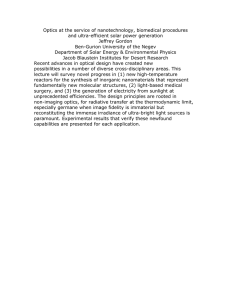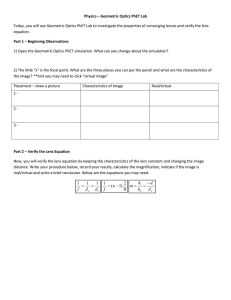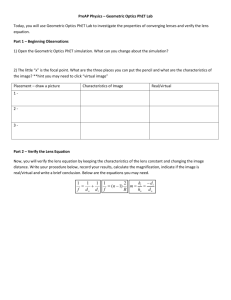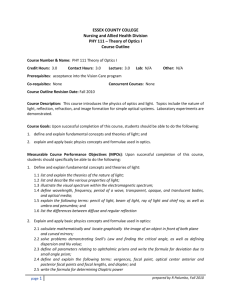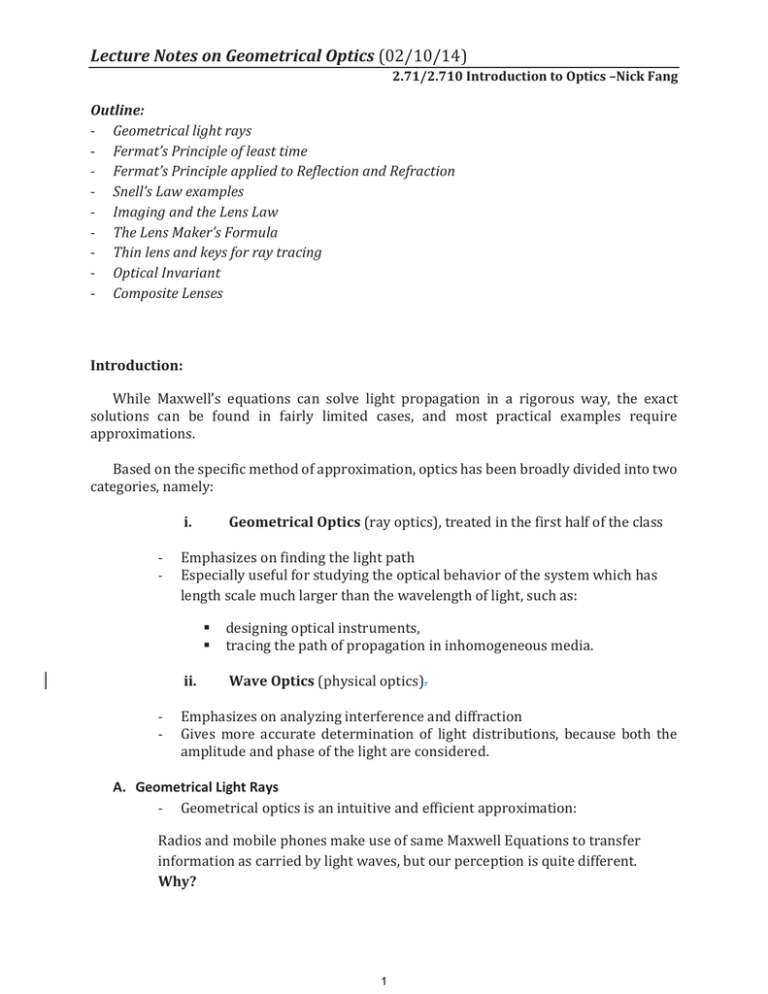
Lecture Notes on Geometrical Optics (02/10/14)
2.71/2.710 Introduction to Optics –Nick Fang
Outline:
- Geometrical light rays
- Fermat’s Principle of least time
- Fermat’s Principle applied to Reflection and Refraction
- Snell’s Law examples
- Imaging and the Lens Law
- The Lens Maker’s Formula
- Thin lens and keys for ray tracing
- Optical Invariant
- Composite Lenses
Introduction:
While Maxwell’s equations can solve light propagation in a rigorous way, the exact
solutions can be found in fairly limited cases, and most practical examples require
approximations.
Based on the specific method of approximation, optics has been broadly divided into two
categories, namely:
i.
-
Geometrical Optics (ray optics), treated in the first half of the class
Emphasizes on finding the light path
Especially useful for studying the optical behavior of the system which has
length scale much larger than the wavelength of light, such as:
�
�
ii.
-
designing optical instruments,
tracing the path of propagation in inhomogeneous media.
Wave Optics (physical optics).
Emphasizes on analyzing interference and diffraction
Gives more accurate determination of light distributions, because both the
amplitude and phase of the light are considered.
A. Geometrical Light Rays
- Geometrical optics is an intuitive and efficient approximation:
Radios and mobile phones make use of same Maxwell Equations to transfer
information as carried by light waves, but our perception is quite different.
Why?
1
Lecture Notes on Geometrical Optics (02/10/14)
2.71/2.710 Introduction to Optics –Nick Fang
We tend to think of light as bundles of rays in our daily life. This is because we
observe the processes (emission, reflection, scattering) at a distance (> 10cms
with bare eyes) that are much longer than the wavelength of light (10-7m or 400­
700nm), and our receivers (retina and CCD pixels) are also considerably large.
In the other end, the wavelength of radio-frequency waves (10cm at 3GHz) is
comparable or sometimes larger than the size and spacing between
transmitting/receiving devices (say, the antennas in your cell phones).
Distance of event
wavelength
Geometric
Optics
Radio
Engineering,
(Scalar) Fourier Optics
Nano-Optics
Vector Field, Polarization
Antennas,
Transmission
lines,
cavities,
amplifiers
Wavelength
min feature size
-
With a common reference (the optical axis in your optical system) to make
the problem as simple as possible, a light ray can be defined by two co­
ordinates:
o its position, x
e
o its slope, e
x
2SWLFDOD[LV
These parameters define a ray vector,
as the ray propagates through optics.
Sign Conventions:
2
which will change with distance and
Lecture Notes on Geometrical Optics (02/10/14)
2.71/2.710 Introduction to Optics –Nick Fang
+ive
curvature
-ive
curvature
positive
ray angle
positive
ray elevation
negative
-ive ray elevation
direction
optical axis
positive
direction
negative
ray angle
� Light travels from left to right
� A radius of curvature is positive if the surface is convex towards the left
� Longitudinal distances are positive if pointing to the right
� Lateral distances are positive if pointing up
� Ray angles are positive if the ray direction is obtained by rotating the +z axis
counterclockwise through an acute angle
Properties of rays:
1) trajectories of “particles of light”
2) Normal to the wavefront surfaces
3) Continuous and piece-wise differentiable 4) Ray trajectories are such as to minimize the “optical path” ⇒ in free space, ray trajectories are straight lines
B. Fermat’s Principle of least time: At first glance, Fermat’s principle is similar to the problem of classical mechanics: finding a possible trajectory of a moving body under a given potential field (We will introduce such Lagrangian or Hamiltonian approach in more detail in the coming lectures about gradient index optics).
3
Lecture Notes on Geometrical Optics (02/10/14)
2.71/2.710 Introduction to Optics –Nick Fang
The underlying argument is, light propagating between two given points P and P’,
would take the shortest path (in time). In order to quantify the variation of light
speed in different medium, we introduce of an index of refraction n:
ܿ
݊ؠ
ݒ
Where:
c~3x108 m/s is speed of light in vacuum;
and v is the speed of light in the medium.
Using the index of refraction, we can define an “Optical Path Length”(OPL):
ܱܲܮሺȞሻ ൌ ݊ ሺݎറሻ݀ݏ
(1)
This is equivalent to finding the total time (�T= OPL/c) required for signals to travel
from P to P’, and vice versa.
How is it consistent with wave picture? Modern theorists like Feynman take more
rigorous approach to show that all other paths that do not require an extreme time
((shortest, longest or stationary) are cancelled out, leaving only the paths defined by
Fermat’s principle.
Under this formulation, we need to find a class of optical paths r (one or more) that
డ
are extreme value (డ௦ ܱܲܮሺȞሻ ൌ Ͳ).
Analogy between Light path and a problem of lifeguard on the beach: Which path
should the lifeguard follow to reach the drowning person in minimum time?
4
Lecture Notes on Geometrical Optics (02/10/14)
2.71/2.710 Introduction to Optics –Nick Fang
C. Fermat’s Principle applied to Reflection and Refraction
a. Application on flat interfaces:
P’
O’
e
e
O
P”
P
Or
mirror
dielectric interface
n
n’
P’
z
x’
e'
z’
e
x
h
P
Figure: The law of reflection (Left) and refraction (Right) over a flat interface using
Fermat’s Principles. Results are the famous Snell’s (Decartes’) Law of refraction and
reflection.
b. Application on curved surfaces:
o Parabolic reflector
- What should the shape function s(x) be in order for the incoming parallel ray
bundle to come to a geometric spot? (Hint: for every path from the incoming
plan wave reflected by the mirror, OPL=2f )
5
Lecture Notes on Geometrical Optics (02/10/14)
2.71/2.710 Introduction to Optics –Nick Fang
S(x)
z
F
focus at F
x
f
Examples of Reflectors: solar concentrators, satellite dishes, radio telescope
6
Lecture Notes on Geometrical Optics (02/10/14)
2.71/2.710 Introduction to Optics –Nick Fang
o
Elliptic refractor x
Refractive
index n
S(x)
F
f
air
glass
D. A Mechanics View of Snell’s Law and examples
We can compare the reflection and refraction of light to that of a ball bouncing off a
hard wall.
While the velocity of the ball changes immediately after collision, its projection
parallel to the wall does not change. This is because there is no force acting on the
ball during the collision process, therefore the momentum does not change along
this direction. The same argument applies to the light ray: the momentum of light
particles in the direction parallel to the “wall” (an ideally flat surface) does not
change during reflection and transmission. Such process is often visualized with the
following graph method with the help of Decartes spheres:
7
Lecture Notes on Geometrical Optics (02/10/14)
2.71/2.710 Introduction to Optics –Nick Fang
p
p //
p
p //
optical
axis
p
p
Index n
Index n’
interface
The half circles represent the amplitude of momentum in different medium (ȁ
ȁ ൌ
݊
ఠ
), and the colored arrows indicates the direction of incident, reflected and
transmitted light beams, and momentum is conserved in the parallel direction,
indicating p // = p' // .
Snell's Law for
many parallel
layers
n1
e1
e2
e2
n2
n3
If the layers are
parallel, then these
angles are always
equal.
n4
e5
8
n5
Lecture Notes on Geometrical Optics (02/10/14)
2.71/2.710 Introduction to Optics –Nick Fang
E. Refraction from a sphere: paraxial approximation
R
es
ein
eout
es
e2
e1
xin
n1
z
n2
Snell's Law is approximated:
ߠ݊݅ݏ௦ ൎ ݔ Ȁܴ
݊ଵ ሺߠ ݔ Τܴሻ ൎ ݊ଶ ሺߠ௨௧ ݔ Τܴሻ
(2)
Two special cases:
-
ߠ ൌ Ͳ: The incoming beams are collimated, and the refracted beams are
converging to a spot at a distance.
ሺ݊ଵ െ ݊ଶ ሻ ݔ Τܴ ൎ ݊ଶ ߠ௨௧ ൎ െ݊ଶ ݔ Τݏi
-
ߠ௨௧ ൌ Ͳ: The beams emitted by a spot at a distance are converted to
collimated outgoing beams after refraction.
݊ଵ ߠ ൎ ሺ݊ଶ െ ݊ଵ ሻ ݔ Τܴ ൎ ݊ଵ ݔ Τ ݏo
F. Imaging and the Lens Law
In the general case
݊ଵ ሺݔ Τ
ݏ ݔ Τܴ ሻ ൎ ݊ଶ ሺെݔ Τ
ݏ ݔ Τܴ ሻ
We find the following relationship:
భ
௦
మ
௦
ൎ
మ ିభ
ோ
(3)
To form a real image with converging beams in both sides, we see that both so and si has to
be larger than a minimum distance. If either of these conditions are broken then we will
obtain a virtual image.
9
Lecture Notes on Geometrical Optics (02/10/14)
2.71/2.710 Introduction to Optics –Nick Fang
G. The Lens Maker’s Formula
Typically a lens is formed with two spherical glass surfaces. Let’s place a second interface
to the right of our spherical glass (without loss of generality, let’s assume the first surface is
generating a virtual image to help our drawing).
On the first interface we obtain:
௦భ
ᇱ
ᇱି
భ
ோభ
௦ ൎ
(4)
Note that Si1 is negative since the image is virtual. For the second interface, we
again use the Eq(3)
ᇱ
௦మ
ିᇱ
మ
ோమ
௦ ൎ
(5)
Also, ݏଶ ൌ ݀െݏଵ . Adding (4) and (5) we find:
݊
݊
ͳ
ͳ
݊Ԣ݀
ൎ ሺ݊ᇱ െ ݊ሻ ൬ െ ൰
ሺ݀ െ ݏଵ ሻݏଵ
ݏଵ ݏଶ
ܴଵ ܴଶ
When the lens is thin (d<<R1, R2), we can neglect the last term. Further, if the
medium is air (n=1), we arrive at the famous Lens maker’s equation:
ଵ
௦భ
ଵ
௦మ
ൎ ሺ݊ᇱ െ ͳሻ ቀ
10
ଵ
ோభ
െ
ଵ
ோమ
ቁ
(6)
Lecture Notes on Geometrical Optics (02/10/14)
2.71/2.710 Introduction to Optics –Nick Fang
Practice Example 1:
I found a glass plano-convex lens thin lens on my shelf and I am using it to image
a light bulb 36cm in front of the lens. Assume the index of refraction is 1.5 and the radius
of the lens is 6cm, where can I find the image behind the lens?
H. Thin Lenses, Ray tracing
3 Simple Rules:
1) Rays parallel to the optical axis (from the left side of lens) are deflected through
the right focal point.
2) Rays passing through the left focal point becomes parallel to the optical axis;
3) Rays passing through the center of the lens remain in the same direction.
11
Lecture Notes on Geometrical Optics (02/10/14)
2.71/2.710 Introduction to Optics –Nick Fang
Figure (Figure 2-22 from Pedrotti)
© Pearson Prentice Hall. All rights reserved. This content is excluded from our Creative
Commons license. For more information, see http://ocw.mit.edu/fairuse.
12
Lecture Notes on Geometrical Optics (02/10/14)
2.71/2.710 Introduction to Optics –Nick Fang
Practice problem 2: A luminous object marked by the arrow and an observing
screen are separated by a fixed distance L>4f (the focal length of the lens). Show that
there are two positions separated by a distance D, where a thin convex lens can be
placed to give a focused image on the observing screen. What is the expression of f as a
function of L and D? This is known as Bessel’s method to find the focal length.
© Pearson Prentice Hall. All rights reserved. This content is excluded from our Creative
Commons license. For more information, see http://ocw.mit.edu/fairuse.
Observation from ray tracing: Magnification ࡹ
ؠ
ൌെ
௦
௦
(since image is
inverted)
I. Optical Invariant
-What happens to an arbitrary “axial” ray that originates from the axial intercept of
the object, after passing through a series of lenses?
13
Lecture Notes on Geometrical Optics (02/10/14)
2.71/2.710 Introduction to Optics –Nick Fang
If we make use of the relationship between launching angle and the imaging
conditions, we have:
ߠ ൌ
௫
௦
ఏ
ఏೠ
and
ൌ
௦
௦
ߠ௨௧ ൌ
ൌെ
௫
௦
Rearranging, we obtain:
ߠ ݄ ൌ ߠ௨௧ ݄
We see that the product of the image height and the angle with respect to the axis
remains a constant. Indeed a more general result, ݄݊ ߠ݊݅ݏ ൌ ݊Ԣ݄ ߠ௨௧ is a
constant (often referred as a Lagrange invariant in different textbooks) across any
surface of the imaging system.
- The invariant may be used to deduce other quantities of the optical system,
without the necessity of certain intermediate ray-tracing calculations.
- You may regard it as a precursor to wave optics: the angles are approximately
proportional to lateral momentum of light, and the image height is equivalent
to separation of two geometric points. For two points that are separated far
apart, there is a limiting angle to transmit their information across the
imaging system.
J. Composite Lenses:
To elaborate the effect of lens in combinations, let’s consider first two lenses
separated by a distance d. We may apply the thin lens equation and cascade the
imaging process by taking the image formed by lens 1 as the object for lens 2.
f2
f1
f1
f2
d
ͳ
ͳ
ͳ ͳ
݀
ൌ൬ ൰െ
ሺ݀ െ ݏଵ ሻݏଵ
ݏଵ ݏଶ
݂ଵ ݂ଶ
14
Lecture Notes on Geometrical Optics (02/10/14)
2.71/2.710 Introduction to Optics –Nick Fang
A few limiting cases:
a)
Parallel beams from the left: ݏଶ is the back-focal length (BFL)
ͳ
݀
ͳ ͳ
ൌ൬ ൰െ
ሺ݀ െ ݂ଵ ሻ݂ଵ
݂ଵ ݂ଶ
b) collimated beams to the right: ݏଵ is the front-focal length (FFL)
ͳ
݀
ͳ ͳ
ൌ൬ ൰െ
ሺ݀ െ ݂ଶ ሻ݂ଶ
݂ଵ ݂ଶ
The composite lens does not have the same apparent focusing length in front and
back end!
c) d=f1+f2: parallel beams illuminating the composite lens will remain parallel at
the exit; the system is often called afocal. This is in fact the principle used in
most telescopes, as the object is located at infinity and the function of the
instrument is to send the image to the eye with a large angle of view. On the
other hand, a point source located at the left focus of the first lens is imaged at
the right focus of the second lens (the two are called conjugate points). This is
often used as a condenser for illumination.
15
MIT OpenCourseWare
http://ocw.mit.edu
2SWLFV
Spring 2014
For information about citing these materials or our Terms of Use, visit: http://ocw.mit.edu/terms.

